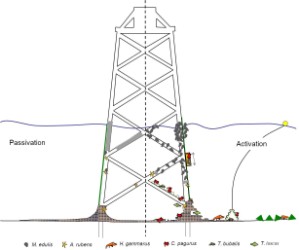|
Reef management: reef activation and reef passivation
The reef effects as well as biofouling and the development of megafauna can significantly be reduced. This is what I name reef passivation. Reef passivation serves for example to mitigate reef effects as for example mytilusation and invasion of Neozoa. Alternatively, all potential reef functions could be activated if the development of a highly valuable artificial reef fauna is intended (e.g. biofouling and megafauna settlement at offshore foundations).
Reef passivation - mitigation of reef effects If foundations are to have minimal impact on the benthic ecosystem, they can be modified in a way which mitigates biofouling and the accumulation of mobile demersal megafauna. With the electrochemical anti-fouling system for structures wetted by sea water, biofouling at the foundations can be prevented. The advantage of this technique is that it is flexible: It can be added after the foundation has already been erected, and can be removed anytime. This technique can be applied to the entire foundation. However, to reduce the biomass accumulation and the spread of hard bottom species in shallow waters, it is particularly the top 5-10 metres of the construction which have to be protected from biofouling.
Reef activation - increasing the reef function Reasons to increase the artificial reef fauna community could be, for example, commercial use and species conservation. In this case the entire foundation could be made more easily accessible to certain species or could be constructed in a way which makes it more attractive for species. The blue mussel (Mytilus edulis) stock can be increased by keeping sea stars (Asterias rubens), the main predator, away from the settlement area. The electrochemical antifouling system may be used as a barrier in deep water levels. In this way A. rubens can be prevented from climbing up the foundation and consuming the mussels. This would allow M. edulis to proliferate into deeper waters. The increase of M. edulis abundance in deeper waters would provide additional food for many predatory species and would result in increased Mytilusation (Krone et al., 2013a, Krone, 2012) through enhanced mussel shell litter fall. The number of predators of biofouling can also be increased by making the blank steel tubes of the foundation more accessible and habitable for megafauna. |

 |  |











